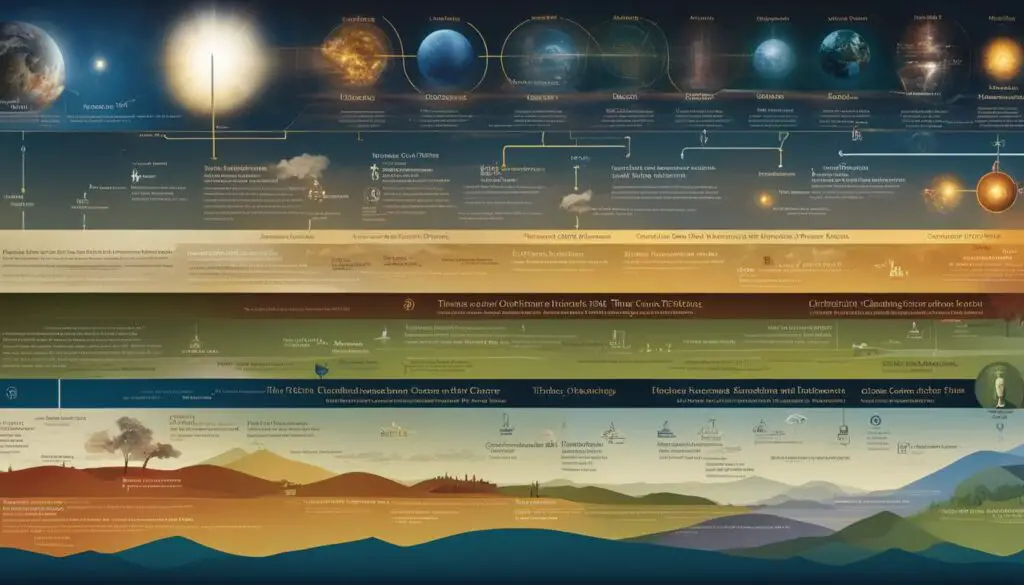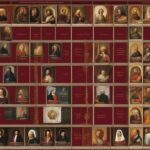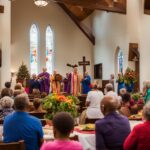The history of the Catholic Church is a captivating journey that spans over two millennia. From its humble beginnings in the 1st century AD to its enduring presence today, the Catholic Church has shaped the spiritual, social, and cultural landscape of the world. Let’s embark on a fascinating exploration of the key moments and developments that have defined the history of the Catholic Church.
Key Takeaways:
- The Catholic Church’s history stretches back to the 1st century AD, making it one of the oldest religious institutions in existence.
- Throughout its history, the Catholic Church has played a central role in the development of Christian theology, engaging in philosophical debates and establishing authoritative scriptures.
- The 4th century witnessed a significant turning point for the Catholic Church with the Edict of Milan, granting religious tolerance, and the First Council of Nicaea, which established core Christian doctrines.
- The Medieval period saw the construction of magnificent cathedrals and the emergence of religious orders, reflecting the deep devotion and zeal of the time.
- The 16th century marked the Protestant Reformation, a period of division and challenges for the Catholic Church, leading to the Council of Trent and subsequent reforms.
1st Century AD: The Early Christian Community
In the 1st century AD, the early Christian community began to form following the crucifixion and resurrection of Jesus Christ. This was a time of immense significance and foundational growth for the Christian faith, as the disciples and followers of Jesus came together to spread his message of love and forgiveness. The teachings of Jesus started to resonate with people, leading to the establishment of a vibrant and devoted community of believers.
The early Christian community fervently shared Jesus’ teachings, spreading his message far and wide. They emphasized the importance of faith in Christ, the transformative power of love, and the hope of eternal life through his sacrifice. This period marked the beginning of a profound spiritual movement that would eventually evolve into the global phenomenon we know as the Catholic Church today.
The early Christian community laid the foundation of the Catholic Church, embracing the teachings of Jesus and establishing the core beliefs that would endure for centuries to come. They faced persecution and hardships, but their unwavering faith and commitment to Jesus’ message propelled the growth of the Christian faith.
“Love one another. As I have loved you, so you must love one another.”
2nd-3rd Centuries: The Development of Christian Theology
During the 2nd and 3rd centuries, the development of Christian theology laid the foundation for the understanding and interpretation of the faith. Early Church Fathers like Ignatius of Antioch and Justin Martyr emerged as significant figures, contributing to theological discussions and defending Christian beliefs.
Ignatius of Antioch, writing in the early 2nd century, emphasized the importance of unity among believers and affirmed the authority of bishops in governing the Church. He addressed theological themes such as Christ’s divinity and the symbolic significance of the Eucharist.
Justin Martyr, a philosopher and theologian in the mid-2nd century, engaged in debates with pagan philosophers and sought to reconcile Christian teachings with Greek philosophy. He defended Christianity against accusations of atheism and immorality, presenting it as the true philosophy that offered salvation through Christ.
“No one will be able to act devoutly towards God if he does not perfectly know him.”
During this period, Christian theology also saw the emergence of significant texts that would become authoritative scriptural sources. The New Testament Gospels, including the synoptic Gospels of Matthew, Mark, and Luke, along with the Gospel of John, presented the life, teachings, death, and resurrection of Jesus Christ. The Epistles, written by early Christian leaders like Paul and Peter, addressed specific theological and practical issues within Christian communities.
This period of theological development set the stage for the subsequent growth and expansion of Christian thought and doctrine. It laid the groundwork for the theological debates and discussions that would shape the future of the Catholic Church.

Key Figures in Christian Theology
| Early Church Fathers | Contributions |
|---|---|
| Ignatius of Antioch | Emphasized the unity of believers, highlighted the authority of bishops, addressed theological themes of Christ’s divinity and the Eucharist. |
| Justin Martyr | Engaged in debates with pagan philosophers, defended Christianity against accusations of atheism and immorality, sought to reconcile Christian teachings with Greek philosophy. |
4th Century: The Edict of Milan and the First Council of Nicaea
In the 4th century, Emperor Constantine issued the Edict of Milan, a monumental decree that brought a newfound era of religious tolerance for Christians. This edict marked a significant turning point for the Catholic Church, as it gained legitimacy and support from the powerful Roman Empire. The Edict of Milan granted Christians the freedom to practice their faith openly, ending centuries of persecution and paving the way for the Church’s growth and influence.
One of the key events that shaped the Catholic Church in the 4th century was the First Council of Nicaea, held in 325 AD. This council was a landmark gathering of bishops and theologians from across the Christian world, convened by Constantine to address various theological disputes that threatened the unity of the Church.
The First Council of Nicaea resulted in the establishment of essential Christian doctrines, most notably the Nicene Creed. This creed articulated the fundamental beliefs of the Church, reaffirming the divinity of Jesus Christ and the concept of the Holy Trinity. The council’s decisions helped solidify the theological foundations of the Catholic Church, providing unity and clarity amidst theological debates.
The Edict of Milan and the First Council of Nicaea were pivotal moments in the history of the Catholic Church, shaping its identity and influencing its trajectory for centuries to come. These events not only granted religious freedom to Christians but also established theological frameworks that continue to guide Catholic doctrine and worship to this day.

By the 4th century, the Catholic Church had come a long way from its humble beginnings in the 1st century AD. It had weathered persecution, confronted theological challenges, and now stood as a recognized and influential force in the Roman Empire. But the story of the Catholic Church was far from over. The subsequent centuries would bring new triumphs, trials, and transformations that would further shape the Church’s history.
5th-7th Centuries: Expansion and Development
The 5th to 7th centuries marked a period of significant expansion and development for Christianity in Europe. During this time, the teachings of Jesus Christ spread across the continent, reaching and influencing various European tribes. This expansion led to the conversion of many individuals and the establishment of Christian communities throughout Europe.
One notable development during this period was the rise of monasticism as a prominent aspect of Christian life. Monastic communities, such as those founded by Saint Benedict, emerged as centers of spiritual devotion and learning. Monks and nuns dedicated themselves to a life of prayer, meditation, and service to God and others.
These developments played a crucial role in shaping the religious and cultural landscape of Europe. The expansion of Christianity contributed to the growth of a unified Christian identity among diverse communities, fostering a sense of shared beliefs and values.
Quote: “In this period of expansion, Christianity spread its roots deep into the hearts of people, transforming not only their spiritual lives but also the socio-political fabric of Europe.”
Development of Monasticism
Monasticism gained prominence during the 5th to 7th centuries, influencing the spiritual and intellectual life of Europe. The establishment of monastic communities provided individuals with opportunities for deep contemplation and withdrawal from secular society.
Monks and nuns devoted themselves to a life of asceticism, living in simplicity and practicing self-discipline in their pursuit of a closer relationship with God. They sought to embody the teachings of Jesus Christ through a meticulous observance of religious rituals, prayer, and meditation.
These monastic communities created spaces for intellectual pursuits, preserving ancient knowledge and contributing to the development of European culture. Monastic libraries amassed vast collections of religious texts, manuscripts, and historical documents, becoming centers of learning and education.
The image below depicts a monastery from the 5th-7th centuries:

Expansion of Christianity
The 5th to 7th centuries witnessed the spread of Christianity across Europe, as missionaries traveled far and wide to share the teachings of Jesus Christ. European tribes, including the Celts, Germanic peoples, and others, embraced Christianity and integrated it into their cultural and social frameworks.
The conversion of these tribes not only brought new followers into the fold of Christianity but also influenced religious practices and merged local traditions with Christian beliefs. This syncretism resulted in the emergence of unique expressions of Christian faith that reflected the diverse cultural contexts in which they developed.
Christianity also benefited from the support of influential rulers who saw it as a means of solidifying political power and establishing a unified identity within their realms. The conversion of these rulers and their subsequent support of Christianity further contributed to the expansion and consolidation of the faith.
| Key Events | Description |
|---|---|
| Conversion of the Franks | Under the leadership of Clovis, the Franks embraced Christianity in the late 5th century, setting a precedent for the conversion of other European tribes. |
| Conversion of the Anglo-Saxons | In the 6th and 7th centuries, missionaries such as St. Augustine of Canterbury played a crucial role in the conversion of the Anglo-Saxon kingdoms in England. |
| Conversion of the Goths | The Visigoths and Ostrogoths converted to Christianity in the 5th and 6th centuries, leading to the establishment of Christian kingdoms in Spain and Italy. |
This period of expansion and development laid the foundation for the further growth and influence of Christianity throughout the Middle Ages and beyond.
8th-11th Centuries: Charlemagne and the Schism
In the 8th century, Charlemagne ascended to the throne and became the Holy Roman Emperor, marking a pivotal moment in the relationship between the Catholic Church and political powers. Charlemagne’s reign brought about a period of religious revival and cultural transformation, where the church and state were closely intertwined.
Charlemagne’s rule not only strengthened the authority of the Catholic Church but also promoted education and the spread of Christianity throughout his empire. The support and favor he bestowed upon the church elevated its influence and solidified its position as a central institution within medieval society.
However, the 11th century gave rise to a significant schism between the Eastern Orthodox Church and the Roman Catholic Church, leading to the division of Christianity into two distinct traditions. This rupture, known as the Great Schism, resulted from a culmination of long-standing tensions and theological differences between the Eastern and Western branches of Christianity.
The Great Schism created lasting divisions in doctrine, liturgy, and governance between the Eastern and Western churches. The Eastern Orthodox Church, centered in Constantinople (present-day Istanbul), retained its own distinct liturgical practices and church hierarchy, while the Roman Catholic Church, headquartered in Rome, continued to establish its authority in the West.

This schism had far-reaching consequences for Christianity, shaping the religious landscape of Europe and beyond. It led to the establishment of two separate theological and ecclesiastical traditions, each with its own cultural and doctrinal identity.
The division between the Eastern and Western branches of Christianity had profound implications for religious, political, and cultural relations between Byzantium and Latin Europe. It significantly influenced the historical development of Christianity over the centuries that followed, leaving a lasting impact on the belief systems and practices of millions of believers.
| Key Points | Significance |
|---|---|
| The rise of Charlemagne | Strengthened the authority of the Catholic Church and promoted Christianity |
| The Great Schism | Resulted in the division of Christianity into Eastern Orthodox and Roman Catholic traditions |
| Consequences and Impact | Shaped the religious, political, and cultural landscape of Europe |
12th-13th Centuries: Height of the Middle Ages
The 12th and 13th centuries were a vibrant and dynamic period of history, known as the height of the Middle Ages. This era witnessed remarkable advancements in art, architecture, and spirituality, leaving a lasting impact on European culture.
During this time, the construction of cathedrals reached its pinnacle, with stunning architectural marvels like the Notre-Dame Cathedral in Paris and the Chartres Cathedral in France. These grand structures, with their towering spires and intricate stonework, served as symbols of faith and aspiration, inspiring awe and reverence in all who beheld them. The cathedrals became focal points of religious pilgrimage and centers for communal worship.
The founding of religious orders also flourished during this period. Monastic communities played a vital role in the spiritual and social fabric of medieval society. Notably, the Franciscans and Dominicans emerged as prominent religious orders, dedicated to acts of charity, education, and the pursuit of knowledge. These orders emphasized compassion, humility, and the pursuit of truth, leaving an indelible imprint on the spiritual and intellectual life of the time.
“The cathedrals of the 12th and 13th centuries stand as testament to the unwavering faith and ingenuity of the medieval Christian community.”
The religious fervor of the 12th and 13th centuries extended beyond the physical realm. The era witnessed a flourishing of religious art and literature, with illuminated manuscripts, biblical frescoes, and stained glass windows depicting biblical stories and Christian teachings. These artistic expressions served to educate and inspire, fostering a deep sense of spiritual devotion among the faithful.
Furthermore, the Middle Ages saw the emergence of great theologians and scholars like Thomas Aquinas, whose works sought to reconcile faith and reason, making significant contributions to the development of Christian theology.
As the Middle Ages reached its zenith, the construction of cathedrals and the founding of religious orders stood as tangible expressions of the deep religious sensibilities of the time. These monumental achievements in architecture and spirituality continue to captivate and inspire people today, serving as enduring reminders of the profound faith and artistic genius of the medieval world.

| Cathedrals | Religious Orders |
|---|---|
| 1. Notre-Dame Cathedral 2. Chartres Cathedral 3. St. Stephen’s Cathedral in Vienna 4. Salisbury Cathedral |
1. Franciscans 2. Dominicans 3. Benedictines 4. Cistercians |
| 5. Milan Cathedral 6. Cologne Cathedral 7. Canterbury Cathedral 8. Durham Cathedral |
5. Carthusians 6. Augustinians 7. Premonstratensians 8. Carmelites |
14th-16th Centuries: Papal Schism and the Protestant Reformation
In the 14th century, the Catholic Church faced a significant challenge in the form of a papal schism. Multiple claimants vied for the title of Pope, causing confusion and division within the Church. This period of conflict weakened the Church’s authority and created a sense of uncertainty among the faithful.
However, it was in the 16th century that the Catholic Church faced one of its most formidable opponents: Martin Luther. The Protestant Reformation, initiated by Luther’s Ninety-Five Theses, questioned the Church’s teachings and practices, challenging its authority.
The Protestant Reformation gained momentum as people began to question the Church’s role in salvation and the practice of indulgences. Luther advocated for a more personal relationship with God, emphasizing faith over works.
Amidst the upheaval, the Catholic Church sought to address these challenges and respond to the growing Protestant movement. The Council of Trent, convened from 1545-1563, played a vital role in this regard.
The Council of Trent was an ecumenical council that aimed to reaffirm and clarify Catholic doctrine, as well as address concerns raised by the Protestant Reformation. The council adopted measures to combat corruption within the Church, address the sale of indulgences, and reinforce the importance of sacraments and the authority of the Pope.
Through the Council of Trent, the Catholic Church sought to address the issues raised by the Protestant Reformation, reaffirming its teachings and providing a clear response to the challenges it faced. This period of reform and renewal marked a pivotal moment in the history of the Catholic Church.
Key Events in the 14th-16th Centuries
| Year | Event |
|---|---|
| 1378-1417 | Papal Schism |
| 1517 | Martin Luther’s Ninety-Five Theses |
| 1545-1563 | Council of Trent |
17th-20th Centuries: Expansion, Challenges, and Modernization
During the 17th to 20th centuries, the Catholic Church underwent a period of expansion, facing both challenges and opportunities for modernization. Missionary work became a driving force in spreading Catholicism to different parts of the world, as believers sought to share their faith and establish new communities. The Church’s influence grew, and its teachings reached distant lands, fostering a global presence.
However, this period was not without difficulties. In the 19th century, the papal states, which were territories under the direct rule of the Pope, were dissolved, resulting in significant political and territorial changes for the Church. This dissolution challenged the Church’s authority and required it to adapt to new circumstances.
In the 20th century, the Catholic Church faced severe scandals related to sexual abuse cases. These cases brought to light the need for accountability and reform within the Church to ensure the safety and well-being of its members. The Church acknowledged the gravity of these situations and took steps to address the issue, implementing measures to prevent abuse and support survivors.
One of the most significant milestones during this period was the Second Vatican Council, known as Vatican II, held from 1962-1965. This ecumenical council aimed to bring the Church into greater harmony with the modern world, promoting dialogue and engagement with various social, cultural, and religious contexts. Vatican II marked a period of modernization and reform that sought to make the Catholic Church more accessible and relevant to contemporary society.
Missionary Work and Global Expansion
The expansion of Catholicism during this period was facilitated by the dedication and commitment of missionaries who ventured into new territories. These devoted individuals traveled to distant lands, often facing challenges, language barriers, and cultural differences, to share the teachings of the Church. Through their efforts, Catholic communities were established, contributing to the growth and diversity of the Church.
The Dissolution of the Papal States
The 19th century saw the dissolution of the papal states, which had long been an integral part of the Church’s governance and influence. This significant shift forced the Church to adapt to a new role within the changing political landscape. It marked a turning point where the Church refocused its efforts on spiritual matters and the promotion of religious principles rather than political control.
Addressing Sexual Abuse Cases
The 20th century brought attention to sexual abuse cases within the Catholic Church, which deeply challenged the credibility and moral authority of the Church. These cases highlighted the need for transparency, accountability, and support for survivors. The Church responded by implementing policies and initiatives to prevent abuse, provide assistance to victims, and ensure the safety of its members.
Vatican II: Modernization and Reform
The Second Vatican Council, Vatican II, was a pivotal event in the Catholic Church’s history. This ecumenical council sought to bridge the gap between tradition and modernity. It introduced significant changes, including the use of vernacular languages in the liturgy, increased emphasis on ecumenism and interfaith dialogue, and a greater engagement with issues of social justice. Vatican II aimed to make the Church more accessible, inclusive, and responsive to the needs of the modern world.
Conclusion
The history of the Catholic Church is a captivating journey filled with moments of triumph and challenges. From its beginnings in the 1st century AD as a small community of believers to its current global presence, the Church has continuously adapted and evolved to meet the needs of its followers.
Despite facing scandals and controversies throughout its history, the Catholic Church remains a powerful force in the lives of millions of believers around the world. The Church’s commitment to the teachings of Jesus Christ, its theological growth, and its engagement with social and cultural changes have helped shape the course of history and continue to guide the lives of countless individuals.
As we look back at the centuries-long timeline of the Catholic Church, it is evident that its impact goes far beyond religious boundaries. The Church has played a significant role in shaping global spirituality, influencing political landscapes, and fostering social and cultural development.
As the Catholic Church moves forward, it will undoubtedly face new challenges and opportunities. Its ability to adapt and remain true to its core values will determine its relevance and influence in the ever-changing world. The story of the Catholic Church is far from over – it is an ongoing narrative of faith, resilience, and profound human experience.
FAQ
What is the timeline of the Catholic Church?
The history of the Catholic Church spans over two millennia, from its origins in the 1st century AD to the present day. It is a rich tapestry that encompasses significant moments and developments in the Church’s evolution.
How did the early Christian community form?
The early Christian community began to form in the 1st century AD following the crucifixion and resurrection of Jesus Christ. His disciples and followers came together to spread his message of love and forgiveness.
What happened in the 2nd-3rd centuries?
The 2nd and 3rd centuries witnessed significant development in Christian theology. Early Church Fathers, such as Ignatius of Antioch and Justin Martyr, contributed to theological discussions and defended Christian beliefs.
What were the key events in the 4th century?
In the 4th century, Emperor Constantine issued the Edict of Milan, granting religious tolerance to Christians. This marked a turning point for the Catholic Church, as it gained legitimacy and support. The First Council of Nicaea was also convened during this time, resulting in the establishment of key Christian doctrines.
How did Christianity expand in the 5th-7th centuries?
The 5th-7th centuries witnessed the expansion of Christianity in Europe, including the conversion of various European tribes. This period also saw the development of monasticism as a prominent aspect of Christian life.
What significant events occurred in the 8th-11th centuries?
In the 8th century, Charlemagne was crowned Holy Roman Emperor, reflecting the close ties between the Catholic Church and political powers. However, the 11th century saw the schism between the Eastern Orthodox Church and the Roman Catholic Church, leading to the division of Christianity into Western and Eastern traditions.
What characterized the 12th-13th centuries?
The 12th and 13th centuries marked the height of the Middle Ages, with the construction of magnificent cathedrals and the founding of various religious orders, such as the Franciscans and Dominicans.
What happened during the 14th-16th centuries?
The 14th century witnessed a papal schism with multiple claimants to the papacy, causing confusion and division within the Catholic Church. In the 16th century, the Protestant Reformation began with Martin Luther challenging the authority and practices of the Church. The Council of Trent addressed these reforms.
How did the Catholic Church evolve in the 17th-20th centuries?
From the 17th to the 20th centuries, the Catholic Church expanded through missionary work, spread to different parts of the world, and faced challenges and scandals. Vatican II, held from 1962-1965, marked a period of modernization and reform within the Church.
What is the significance of the Catholic Church’s history?
The history of the Catholic Church is a complex narrative that spans centuries of religious, social, and political changes. It showcases the Church’s growth and adaptation while remaining steadfast in its commitment to the teachings of Jesus Christ.
















